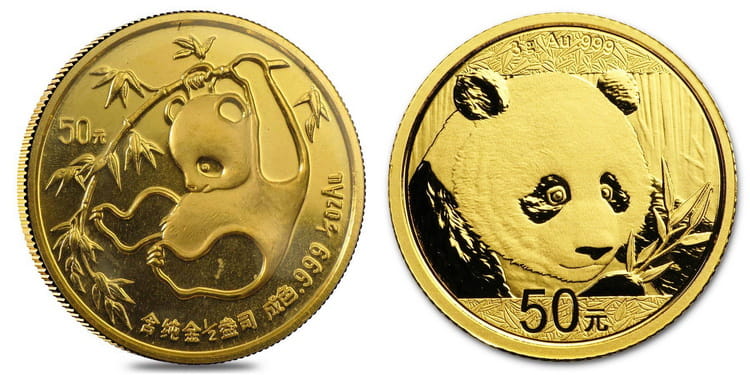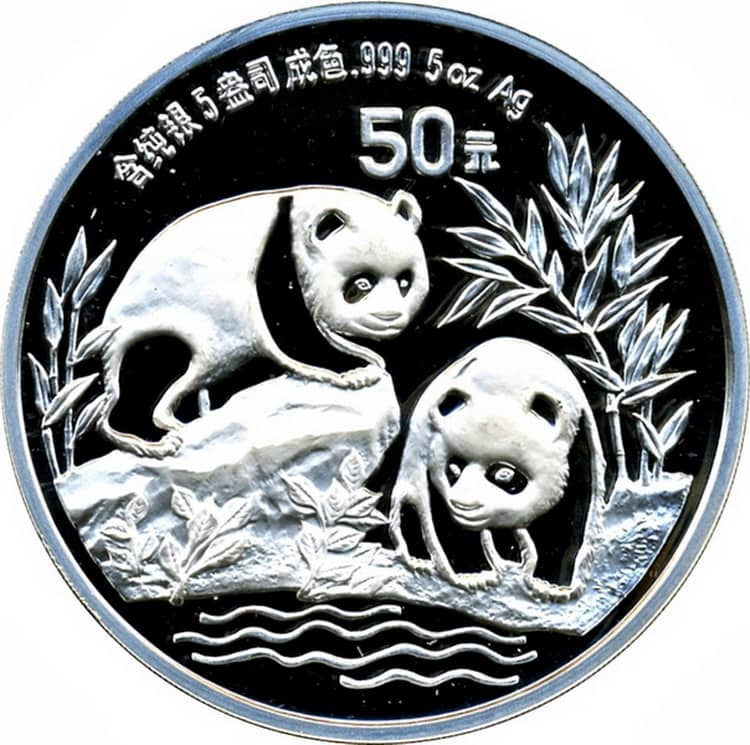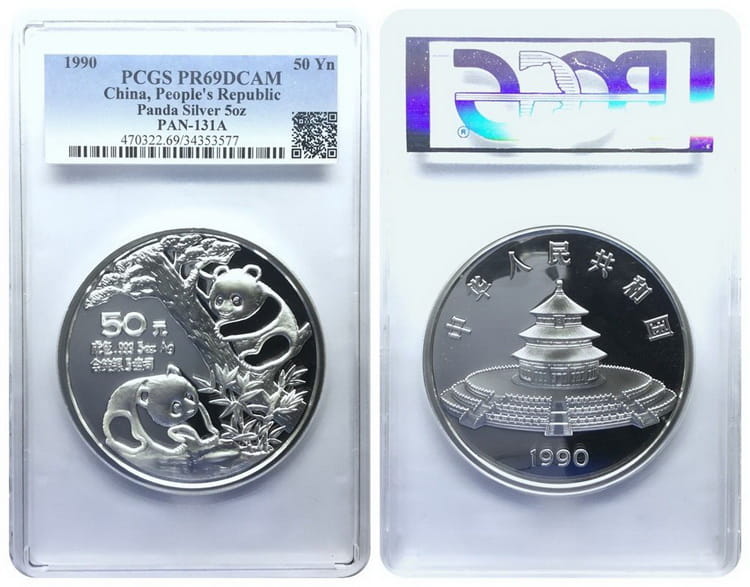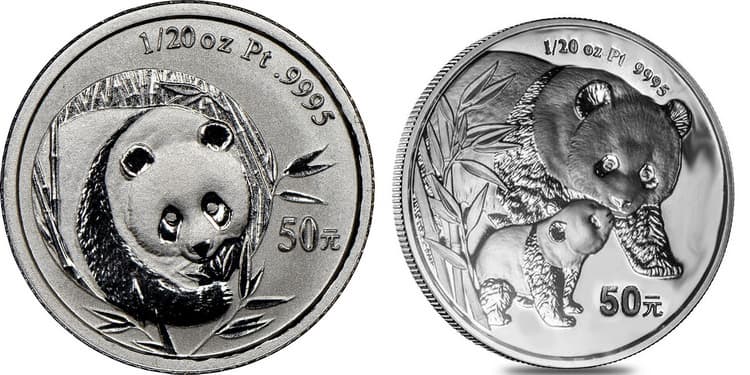
Fifty yuans is a сollectible coin, issued by the mints of China from 1982 to the present day. Currently, Chinese collectible coins are gaining popularity, winning the hearts of collectors, as well as investors from all over the world. You can find 50 Yuan Chinese gold coins in our catalog.
Fifty yuan gold coins from the Panda series
The Chinese government began to mint the gold coins with a face value of 50 yuan from the Panda series in 1982. The design of the reverse of the coin changes every year (with the exception of the emissions of 2000-2001), the size and weight changed only once, in 2001.
Years of minting: 1982-2000/2001 – present day.
Metal: gold.
Weight: 15.55 g /3.11 g
Diameter: 27 mm /17.95 mm
Thickness: 1.85 мм /1.05 mm
Obverse: famous Peking Temple of Heaven; inscription “Zhonghua Renmin Gongheguo”, meaning “People’s Republic of China”; year of minting.
The obverse is the same in all copies; the only exception is jubilee items. They have special marks on their front side.
Reverse: images of pandas eating bamboo or sitting on trees, or rocks; weight of the coin; fineness of the metal; face value.
To understand how the 50 yuan series looks, see the photo.

50 Yuan 2011 Chinese gold coin in our catalog.
Fifty yuan silver coins from the Panda series
The first silver coins of the Panda series were produced in 1983-1985 with the Proof quality, were made from silver with a fineness of 0.900, they weighed about 27 grams and had a diameter of 38.6 mm. The emission was 10,000 copies every year. In 1986, silver pandas were not produced, and in 1987, they were minted from one troy ounce of silver with a fineness of 925 and diameter from 40 mm. All 50 Yuan Chinese silver coins in our catalog.
Years of minting: 1983 – present day.
Metal: silver
Weight: 155.5 g
Diameter: 70 mm
Thickness: 6 mm
Obverse: famous Peking Temple of Heaven; inscription “Zhonghua Renmin Gongheguo”, meaning “People’s Republic of China”; year of minting.
The obverse is the same in all copies; the only exception is jubilee items. They have special marks on their front side.
Reverse: images of pandas eating bamboo or sitting on trees, or rocks; weight of the coin; fineness of the metal; face value.
To understand how the 50 yuan series looks, see the photo.

Fifty yuan platinum coins from Panda series
All the pandas of platinum, except for those produced in 2004 and 2005, are rare, while having a rather limited circulation. However, even a relatively large circulation will not guarantee the availability of the coin, since many platinum coins of the series have been melted down, and even professional dealers often do not have a complete set of issued copies. In recent years, prices for platinum coins in the series have grown significantly, and this was not only due to fluctuations in prices for metal but also because the welfare of the Chinese population who need bullion coins is growing.
Years of minting: 1990 and 2003/2004.
Metal: platinum
Weight: 15.55 g and 1.55 g
Diameter: 27 mm and 14 mm
Two pandas are depicted on the reverse of the coin of 1990. One clings to a tree, other sits next to it. The stems of bamboo are visible at the foot of the tree. The denomination, fineness, and weight of the coin are indicated at the top. The reverse of the coin of 2003 depicts a panda that is eating with bamboo. On the back of the coin of 2004, a mother-panda with a bear cub is engraved, standing at the bamboo thickets. The obverse of all coins is the same as on gold and silver copies of the series.

Fifty yuan coins from the Inventions and Discoveries series
Year of minting: 1995
Metal: gold
Weight: 15.55 g
Diameter: 27 mm
There were issued five coins of this denomination in the series. A 50-yuan coin, made of gold, called The First Chess (or Chinese Chess) deserves special attention. It was minted in China only once – in 1995, as part of the Inventions and Discoveries series. At the moment, all coins of this face value of the series are in short supply. They are not available for free sale. Like other rare Chinese coins from gold and silver, chess is searched continuously by collectors and investors around the world.
Obverse: section of the great Chinese wall with a majestic tower; year of minting; inscription “People’s Republic of China”.
Reverse: two Chinese people in national costumes, playing chess; face value of the coin.

On the reverse of other coins of the series, there are images of various inventions of Chinese people: a printing press, a pottery workshop, acupuncture, gun, and gunpowder.

Coins of other series
In addition to the popular coins of this denomination, which are in demand, China can boast of original series of unique items, which are produced in lesser circulations.
- The Three Gorges Dam coin (gold, 1996) is unique because of its square form. It depicts the famous dam on the Yangtze River, which is also one of the world’s two largest hydroelectric power stations.
- The Chibi War coin (gold, 1997) is dedicated to the two kingdoms period in ancient China and the spectacular sea battle between two contenders to the throne, which ended with the burning of the fleet of one of them.
- The coin Return of Hong Kong (gold, 1995) was issued in honor of this memorable event in limited circulation. Today the cost of these coins ranges from 1,400 to 3,500 thousand dollars.
- The Peking Opera coin (gold, 1999) is dedicated to the world famous Chinese opera of the East. This coin is painted in bright colors of makeup and clothes of an actor who is depicted on the obverse.
Cost of coins
Due to the constantly rising prices on precious metals, and also due to the emergence of a certain deficit of Chinese coins, copies of the 50 yuan denomination are sold on trade platforms at 500-600 dollars per piece. The rarest bullion coins are estimated at 2-3 thousand dollars. You can find all Chinese gold and Silver coins in our catalog.
Interesting facts
- During all years of minting, the modern Chinese gold and silver coins of the Panda series were minted by various mints in Shanghai, Shenyang, and Shenzhen. In different countries of the world (for example, in the USA), various mints have a particular label, marking the coins of own production, so that collectors could distinguish them. This does not apply to Chinese mints. You can see some differences only during a careful examination of the coins, for example, the size of the temple on the obverse and the font of the year of issue of the item. First of all, silver coins Panda of 1996 are famous by such differences.
- In 2015, all the coins of the Panda series, both silver, and gold, didn’t have the usual marks about the quality of metal and weight. This situation caused a big stir among the collectors and investors.
Comments
No commens yet.